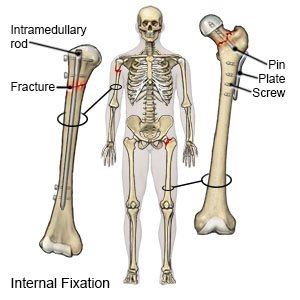Intramedullary Nailing
Medically reviewed by Drugs.com. Last updated on Apr 6, 2025.
What do I need to know about intramedullary nailing?
Intramedullary nailing is surgery to repair a broken bone and keep it stable. The most common bones fixed by this procedure are the thigh, shin, hip, and upper arm. A permanent nail or rod is placed into the center of the bone. It will help you be able to put weight on the bone.
 |
How do I prepare for surgery?
Your surgeon will talk to you about how to prepare for surgery. Do not eat or drink anything after midnight on the day of your surgery. Your surgeon will tell you which medicines to take or not take on the day of your surgery. You will be given an antibiotic through your IV to help prevent a bacterial infection.
Drugs used to treat this and similar conditions
Prolia
Prolia (denosumab) is an injection that is administered subcutaneously (under the skin) once every ...
Fosamax
Fosamax (alendronate) is used to treat or prevent postmenopausal osteoporosis and steroid-induced ...
Repatha
Repatha (evolocumab) is a PCSK9 inhibitor used to lower high cholesterol alongside dietary changes ...
Forteo
Forteo injection is used to treat osteoporosis in men and postmenopausal women who are at high risk ...
Evenity
Evenity (romosozumab) injection is used to treat osteoporosis in postmenopausal women to reduce the ...
Tymlos
Tymlos (abaloparatide) is used to treat osteoporosis in men and postmenopausal women who have a ...
Romosozumab
Romosozumab is used to treat osteoporosis in postmenopausal women at high risk of fractures. It is ...
What will happen during surgery?
- You may be given general anesthesia to keep you asleep and free from pain during surgery. You may get medicine to block pain in nerves that are near the surgery site. Numbing medicine may be injected into your spine if you are having a leg bone repaired. You will be awake if you have a spinal injection, but you will not feel pain.
- Surgery is usually done through small incisions made in the skin. Your surgeon will thread a guidewire into the center of the bone. A device may be used to make the bone hollow. Your surgeon will then line up the broken ends of the bone. The nail will then be inserted into the hollow part of bone to keep the bones lined up. Locking screws will be placed on both ends to keep the nail in place. Stitches or staples may be used to close the incisions.
What will happen after surgery?
- Your legs may be numb for 6 to 12 hours after surgery if you had a spinal injection. You may have swelling and pain in your leg from surgery. This is normal and should get better within a few days. You may be given medicines to reduce pain and swelling.
- You will need to walk around on the day of surgery, or the day after. This will help prevent blood clots. It also puts weight on the bone. Weightbearing is important for strengthening the bone. You may need to wait until the bone heals before you put your full weight on the bone. Healthcare providers may have you use crutches or another support device.
- Deep breathing exercises help open your airway and decrease your risk for a lung infection. Take a deep breath and hold it for as long as you can. Let the air out and then cough strongly. You may be given an incentive spirometer to help you take deep breaths. Put the plastic piece in your mouth and take a slow, deep breath, then let the air out and cough. Do the exercises 10 times every hour.
- A pressure stocking will be used to increase blood flow and prevent blood clots. This is a long, tight stocking. It puts pressure on your legs and moves blood out of lower leg veins. You may also be given blood thinning medicine to help prevent clots.
- A physical therapist may teach you exercises to help your leg heal. The exercises can also help strengthen muscles and keep your joints flexible.
What are the risks of intramedullary nailing?
- You may have an allergic reaction to the anesthesia or to the antibiotics. You may develop compartment syndrome. This is a condition that develops when too much pressure builds within muscles. Blood cannot flow to muscles and tissues. This can cause severe muscle and nerve damage that can become permanent.
- Your fracture may heal in an abnormal position. The ends of the fracture may not join correctly. This can prevent healing. The nail or rod used may bend or fail. You may need surgery again if this happens. You may also have damage to nerves or blood vessels. The damage can cause temporary or permanent numbness. You may also feel irritation in the area where screws were placed.
Care Agreement
You have the right to help plan your care. Learn about your health condition and how it may be treated. Discuss treatment options with your healthcare providers to decide what care you want to receive. You always have the right to refuse treatment. The above information is an educational aid only. It is not intended as medical advice for individual conditions or treatments. Talk to your doctor, nurse or pharmacist before following any medical regimen to see if it is safe and effective for you.© Copyright Merative 2025 Information is for End User's use only and may not be sold, redistributed or otherwise used for commercial purposes.
Further information
Always consult your healthcare provider to ensure the information displayed on this page applies to your personal circumstances.
